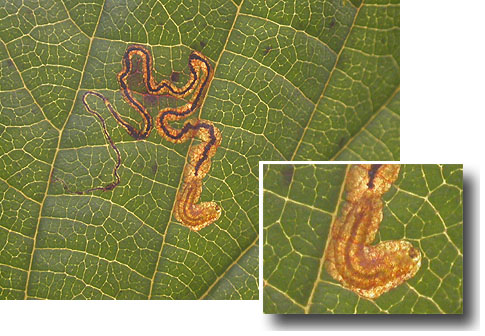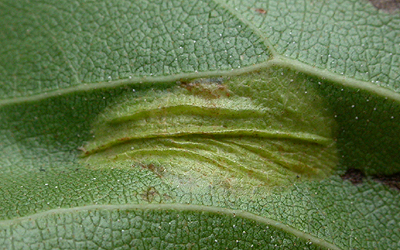

| A short introduction to leafmining moths |
| A calendar of Nottinghamshire leaf-mining moths |
| Leafmines are the characteristic galleries created on either the upper or lower surfaces of leaves. Most mines are created by the internal feeding of lepidoptera larvae within the leaf, but others are the result of coleoptera, diptera or hymenoptera larval stages. Only lepidopterous mines will be dealt with here. |
| ............... | ||
 |
The study and
identification of leafmines, usually develops as a
progression from an earlier interest in larger moths. Moth trapping invariably attracts a wide range of smaller (micro) moths and once entering into their identification, the interest in leafmines usually develops. This certainly happened in our case. If we were to be serious about recording moths, then that should include all species and in the past few years, we have discovered many species new to Nottinghamshire, purely because no one else has ever really bothered to record them for many years. While there is a good knowledge of the county's larger moths, virtually nothing is known of the micro moths and in particular, the leafmining moths. |
|
| ............... | ||
| Recording leafmines can extend the mothing season until well into November or even December, until the last of the leaves fall off, but most important of all, will provide valuable data to a very scant Nottinghamshire micro moth database. Oddly enough, leafmine identification is not as difficult as one might be led to believe and there are several excellent websites available, with easy to use identification keys. | ||
| ............... | ||
| Leafmining insect groups | ||||||||||||||
|
||||||||||||||
| The blotch forming leafminers feature one particularly notorious and very well known species. Cameraria ohridella (the Horse Chestnut Leafminer) has become a familiar sight since arriving in Nottinghamshire nearly ten years ago, with literally tens of thousands of leafmines, covering virtually every Horse Chestnut tree within the county by late Summer. | |||
| ............... | |||
 Phyllonorycter rajella |
C.
ohridella produces one of the most obvious upper
surface blotch mines, but the leafmines produced by other
species, are often more discreet and although they are
visible on the upper leaf surface, are actually lower
surface leafmines. Some of the most frequently recorded leafmines are those produced by the larvae of the Eriocranias and Phyllonorycters. Eriocrania mines are easy to distinguish and are among the first leafmines to appear in the Spring. Although most Eriocranias are Birch feeders, a combination of frass dispersal pattern, larval colour and even the number of larvae sharing the same mine, means that this is a relatively easy group of blotch miners to start with. |
||
| ............... | |||
| ............... | ||
| The leafmines of many
species don't start to appear till late in the year and a
number of them will not be found much before late October
or November. While ever there are leaves on trees, it will always be possible to look for leafmines. But even when the last of the leaves have fallen, there is still a number of mines that can be looked for. Looking on the fallen leaves of Oak for characteristic 'green islands' will often reveal the presence of species such as Ectoedemia subbimaculella and Ectoedemia heringi, two common leafminers. The 'green island' caused by the larva of Ectoedemia argyropeza, is shown in the accompanying photograph. These are surprisingly easy to find when the moth is present at a site on fallen Aspen leaves. A good number of micromoths actively mine the needles of various Pines. Scots Pine is probably the most productive of all and even trees in urban areas, parks or gardens, will probably hold at least one species. |
Ectoedemia argyropeza |
|